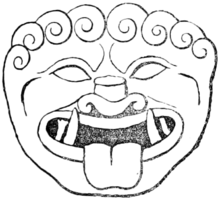hair into snakes, while the face is anything but ugly. This is from a Greek pre-affix found at Taranto, and now in my own collection. It is one of those I had the honour of exhibiting to the Society of Antiquaries in 1898. These pre-affixes are all apparently of the same age, about 350 B.C.[1] I have another from the same place and of the same period, which I also exhibited, of the other type with the wide mouth, split tongue, and hair arranged in very short curls, of a peculiar twist which is quite conventional.
The Etruscan head, (Fig. 7,) from Chiusi[2] fairly represents the curls and general aspect of my second Tarantine Medusa.

Fig. 7. |
The existence of two original Greek heads, both of a period so long anterior to Pompeii, proves conclusively that the two distinct types of feature existed in very early ages. Here I would specially call attention to the fact that all the Greek Medusæ of old type, as well as the older Etruscan ones, have the hair arranged in crisp little curls, very much in the style of Fig. 7. Particularly is this to be seen on the pre-affix referred to in my possession, and on the famous Gorgon guarding the tomb of the Volumni at Perugia. It is also a distinct feature on the bronze Etruscan lamp, now in the museum at Cortona, of which I give a partial sketch (Fig. 8). I have dwelt particularly on the absence of snakes on the early Gorgons, for the reason that I have to show from whence that attribute is developed. In this Cortona lamp, too, I would direct attention to the border, in which are to be seen alternate sirens, capi di bove, sea-gods, and fish, with
